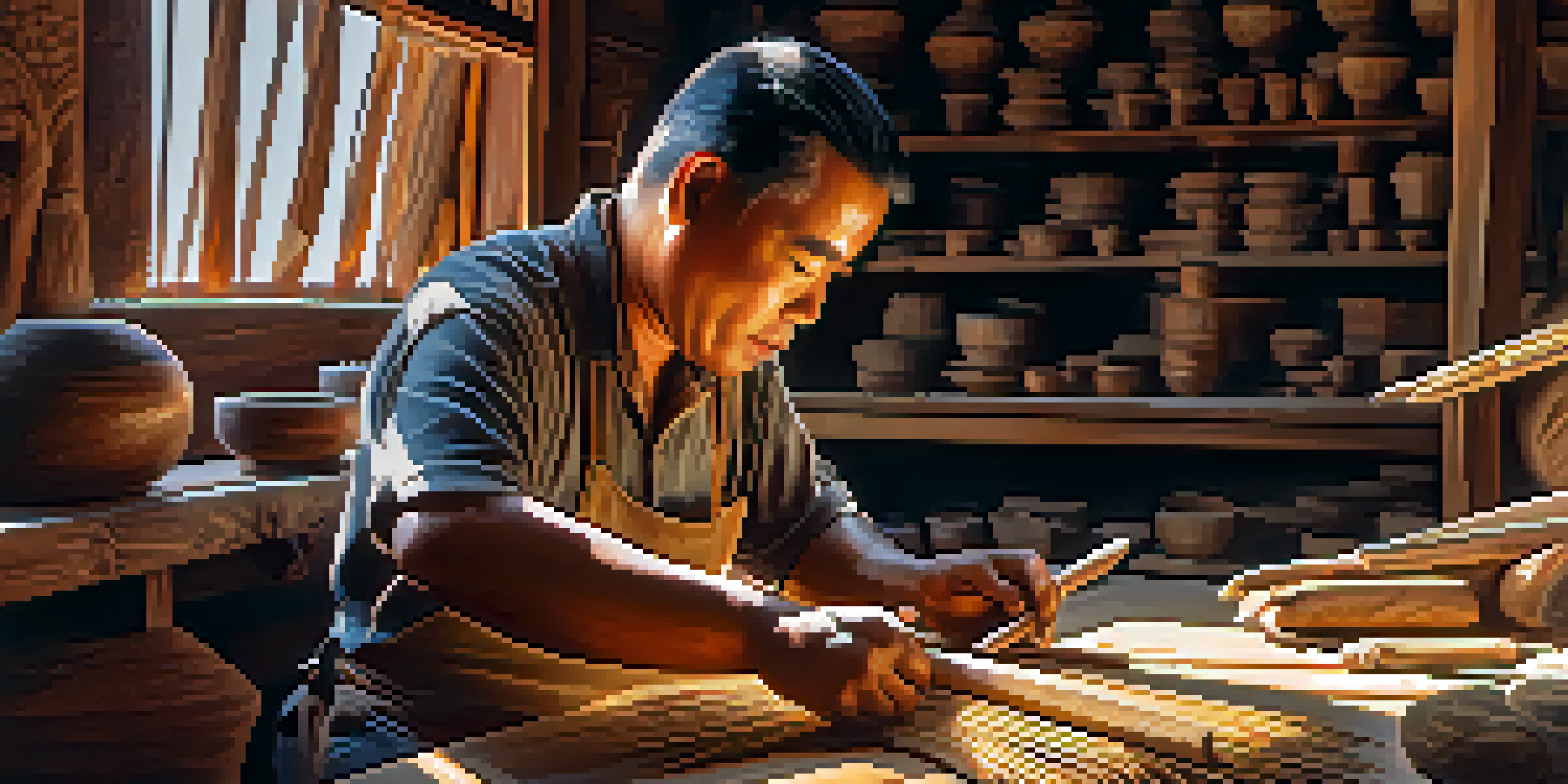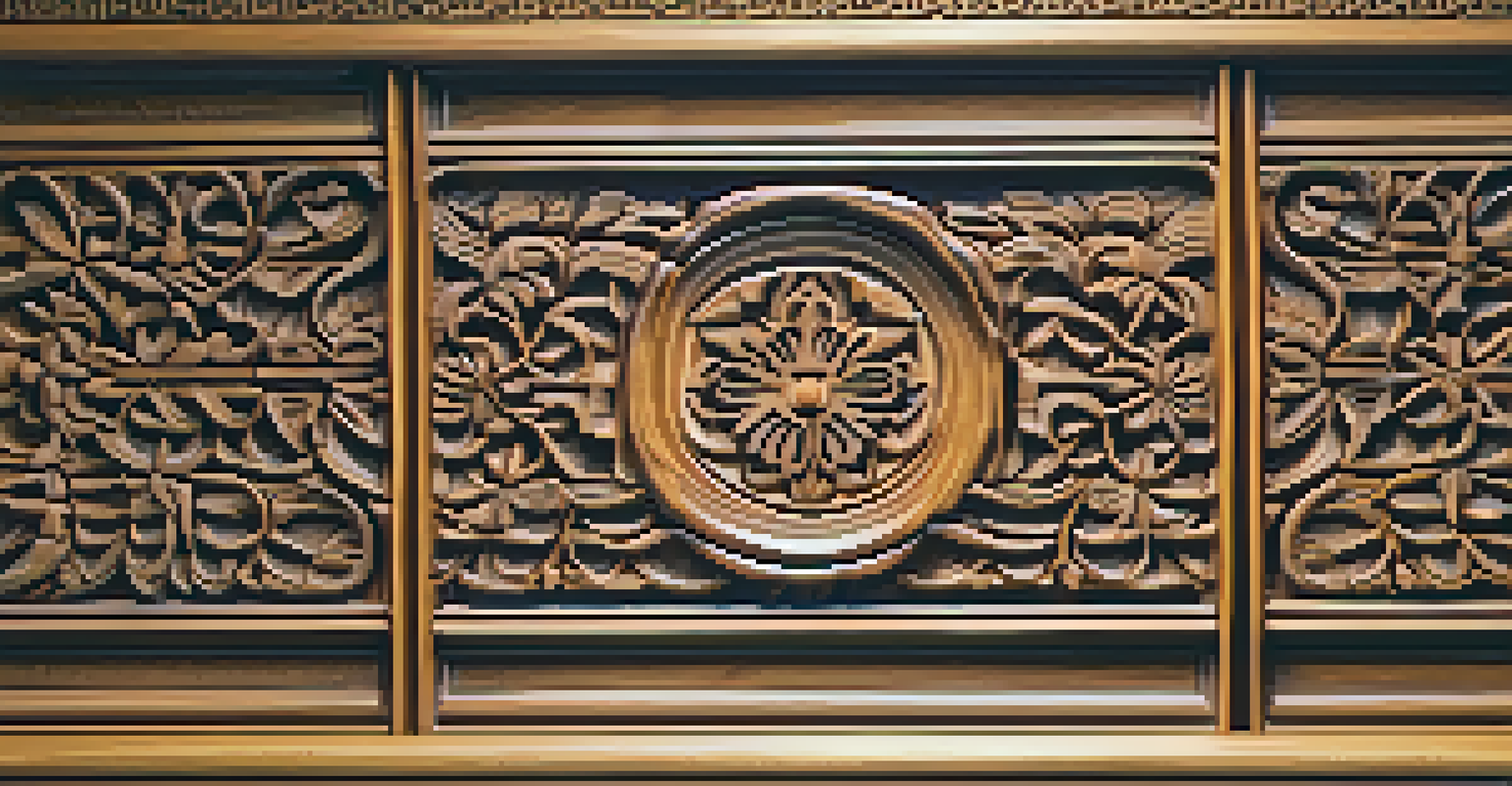Wood Carving in Thailand: Craftsmanship and Symbolism

Understanding the History of Thai Wood Carving
Wood carving in Thailand has a rich history that dates back centuries, deeply intertwined with the country's cultural and religious practices. Traditionally, artisans crafted intricate designs for temples and palaces, showcasing their skills and devotion. This craft not only reflects aesthetic beauty but also embodies spiritual significance, often depicting various deities and mythical creatures.
Every piece of wood has a story to tell, and it is the carver's hands that breathe life into it.
Over time, these carvings have evolved, influenced by the different cultures and religions that have passed through Thailand. For instance, the integration of Hindu and Buddhist themes can be seen in many traditional pieces. As a result, wood carving has become a unique blend of artistic expression and cultural storytelling.
Today, this ancient art form is celebrated not just in Thailand but around the world. Many artisans continue to hold onto traditional techniques, passing them down through generations, ensuring that the historical roots of Thai wood carving remain alive and vibrant.
The Craftsmanship Behind Thai Wood Carving
The craftsmanship of Thai wood carving is nothing short of remarkable, requiring years of practice and dedication. Artisans often start as apprentices, learning the intricacies of their craft from skilled masters. This mentorship is crucial as it helps preserve traditional methods while allowing for personal expression in their work.

Typically, Thai wood carvers use a variety of native woods, such as teak and rosewood, which are known for their durability and beauty. The selection of wood plays a significant role in the final outcome, as different types can lend unique textures and colors to the carvings. Each piece is meticulously shaped using hand tools, ensuring that every detail is perfect.
Rich History of Thai Wood Carving
Thai wood carving has deep cultural and spiritual roots, showcasing intricate designs that reflect the country's heritage.
Moreover, the process of wood carving is deeply meditative for many artisans. As they carve, they often enter a state of flow, where time seems to stand still. This connection between the artist and their work infuses each piece with a sense of soul, making every carving not just a product, but a narrative that speaks of dedication and artistry.
Symbolism in Thai Wood Carvings
Symbolism plays a vital role in Thai wood carving, with many designs representing various cultural and spiritual meanings. For instance, carvings of the mythical Naga, a serpent-like creature, symbolize protection and abundance. Such representations are often incorporated into temple structures, serving both decorative and protective functions.
Art is not what you see, but what you make others see.
Additionally, floral and geometric patterns are common, each carrying its own significance. Lotus flowers, for example, symbolize purity and enlightenment within Buddhism, making them a popular motif in many carvings. This merging of aesthetics and meaning is what makes Thai wood carving so captivating and layered.
Understanding the symbolism behind these carvings can deepen our appreciation for this craft. It transforms each piece from merely a decorative object into a vessel of culture and belief, inviting viewers to explore the narratives woven into the wood.
The Role of Thai Wood Carving in Modern Culture
In contemporary Thailand, wood carving continues to hold a significant place in both art and culture. While traditional techniques are still revered, many modern artisans are experimenting with new styles and themes. This blend of old and new creates a dynamic art scene that attracts both locals and tourists alike.
Many artisans now participate in exhibitions and fairs, showcasing their work to a broader audience. This not only helps in promoting their craft but also encourages the preservation of traditional methods. As a result, younger generations are becoming more interested in learning wood carving, ensuring that this art form remains vibrant and relevant.
Challenges Facing Modern Artisans
Artisans face challenges such as resource scarcity and a decline in skilled craftsmen, threatening the survival of traditional techniques.
Moreover, tourism has played a crucial role in the revival of Thai wood carving. Visitors are often drawn to the unique craftsmanship and cultural significance behind each piece, leading to a growing market for authentic, handcrafted wood art. This interest helps sustain the livelihoods of artisans while keeping the traditions alive.
Famous Wood Carving Centers in Thailand
Certain regions in Thailand are renowned for their exceptional wood carving, with each area showcasing its unique style and techniques. Chiang Mai, in northern Thailand, is particularly famous for its intricate carvings, often depicting scenes from Thai folklore and mythology. The city's rich cultural heritage makes it a hub for both artisans and enthusiasts.
Another notable center is the town of Pattaya, which has gained recognition for its impressive wood carving exhibitions. Here, visitors can witness artisans at work and even participate in workshops, making it a fantastic opportunity to connect with this art form. The vibrant atmosphere of Pattaya contributes to the popularity of wood carving among tourists.
Lastly, the province of Phuket is also known for its wood carving, especially in the context of traditional Thai architecture. Many temples and buildings feature stunning woodwork that reflects the area's cultural identity. Each of these regions contributes to the rich tapestry of Thai wood carving, ensuring that the tradition continues to thrive.
Challenges Facing Thai Wood Carving Artisans
Despite its rich heritage, Thai wood carving faces several challenges in the modern world. One significant issue is the availability of quality raw materials, as deforestation and environmental regulations impact the sourcing of traditional woods. This scarcity can lead to increased costs and a reliance on less sustainable alternatives.
Additionally, the younger generation is often drawn to urban life and more lucrative careers, leading to a decline in the number of skilled artisans. This shift poses a risk to the survival of traditional techniques and knowledge that have been passed down for generations. Without proper support and encouragement, these valuable skills may fade away.
Future of Wood Carving Looks Bright
Growing appreciation for handcrafted art and e-commerce opportunities are revitalizing interest in Thai wood carving.
To counteract these challenges, initiatives are being developed to promote sustainable practices and support artisans. Workshops, grants, and educational programs are being established to foster a new generation of wood carvers who can carry on the tradition while adapting to modern demands. These efforts aim to ensure that Thai wood carving continues to flourish for years to come.
The Future of Wood Carving in Thailand
Looking ahead, the future of wood carving in Thailand appears promising, thanks to the growing appreciation for handcrafted art. As consumers become more conscious of sustainability and local craftsmanship, there is a resurgence of interest in traditional skills. This trend is encouraging artisans to innovate while staying true to their roots.
Moreover, the rise of e-commerce has opened new avenues for artisans to reach a global audience. Online platforms allow them to showcase their work and connect with customers beyond the local market. This increased visibility can help sustain their livelihoods and promote the cultural significance of Thai wood carving worldwide.

Ultimately, the future of wood carving in Thailand will depend on the balance between preserving tradition and embracing modernity. By fostering a culture that values both, artisans can continue to create stunning pieces that reflect their heritage while appealing to contemporary tastes. This harmonious blend will ensure that the art of wood carving remains a vital part of Thailand's cultural landscape.